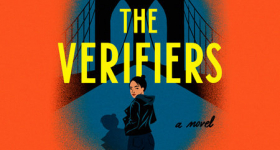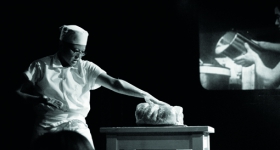Among the narratives in the relatively short history of Cambodians in the United States, the survival story of escaping autogenocide and starting anew in a foreign country pervades. The Khmer Rouge’s invasion of Cambodia in 1975 forced most citizens into labor camps and led masses to flee once the camps were dismantled. Survival stories have served as a form of healing for Cambodian Americans and as a cathartic way of coming to terms with their wrought past.
Until recently, the narrative paradigm for most Cambodian stories in film begins in blissful, pre-Khmer Rouge Cambodia and concludes with the flight of refugees to another country. However, a new crop of Cambodian films have begun moving beyond a focus on trauma to the survival of day-to-day anguish experienced within the Cambodian community in contemporary U.S. society. Three films, in particular – Samnang (2012), Paulina (2012) and A River Changes Course (2013) – illuminate the deeply-held yearning for normalcy and battle for self-preservation that follow the experience of trauma after immigration to a foreign country. Today, new approaches at storytelling are emerging as the 1.5 generation of Cambodians (or Khmers) in America moves into adulthood.
The term “one-and-a-half-generation” was first coined in the 1970s by sociologist Rubén Rumbaut to describe Cuban immigrant youths who came of age in America. Similarly, the 1.5 generation of Khmers in the United States today are those adults who were born in Cambodia during or shortly after the fall of the Khmer Rouge, or in Thai refugee camps after their parents fled their homeland.
With roots in Cambodia and present lives in America, 1.5-ers often feel that neither country completely defines their cultural identity. From the understated yet poignant depictions of solitary immigrant life by writer Vanara Taing in Samnang, to the portrayal of gambling addiction and post-traumatic stress disorder in Caylee So’s Paulina or the dire presentation of Cambodia’s ecological predicament in Kalyanee Mam’s A River Changes Course, 1.5 generation filmmakers’ contemporary stories move beyond their predecessors’ traumatic narratives of war, autogenocide and dislocation toward new ways of formulating questions around issues of culture and historical identity.
Prologue: The Killing Fields
During the four years of authoritarian reign by the Khmer Rouge’s leader Pol Pot, close to 2 million people were killed by the regime. After the Vietnamese army overthrew the Khmer Rouge in 1979, nearly 200,000 Cambodians fled to refugee camps in Thailand where they awaited resettlement in various Western countries.
Cambodian refugees came to the United States in the late 1970s and early 1980s. During this period came the film that introduced the Khmer Rouge occupation of Cambodia to international audiences: The Killing Fields (1984). The film, directed by Roland Joffe, follows the relationship between an American journalist and a Khmer photographer as it develops during the occupation of Phnom Penh. Dr. Haing Ngor, himself a survivor from the fall of Phnom Penh, played the photographer Dith Pran in the film and went on to release a memoir that became one of the earliest first-person accounts of the Khmer genocide to be written by a Cambodian.
In contrast to the films produced today by 1.5 Cambodian filmmakers, the first-generation storylines that trace characters’ flight from danger to safety epitomized by The Killing Fields limited the depiction of Cambodian history to the Khmer Rouge timeline and distilled it down to representations of bloody, gruesome conflict.
While films by first-generation filmmakers tend to be neatly resolved, culminating in eventual escape to the open arms of foreign safety, the narratives of the 1.5 generation are more ambivalent toward notions commonly surrounding immigrant experiences, such as acculturation, assimilation, abandonment, forgetfulness and hope. The 1.5 stories simultaneously look forward and back, with characters searching for guidance from the past and yet finding the search at odds with present-day desires in their current life in America.
A lesson in the other uses for flour in Samnang.
Love and the Normal Life: Samnang
It is well past midnight and the streets are empty. Inside a dingy doughnut shop, a gruff, bald-headed baker toils away in the kitchen while listening to an educational CD of American phrases translated into Khmer. A recorded female voice states, “My family is in trouble,” and the baker repeats the phrase with a comedic flourish, then smacks the dough against the table.
This is the opening scene of the short, 22-minute film Samnang, written by Vanara Taing. Billed as a “donut shop love story,” the film portrays the quiet, solitary life of a recently-widowed, middle-aged Cambodian man. Named after its protagonist, the film moves slowly, repeating Samnang’s lonely daily routine of biking to and from his cramped, roommate-filled apartment to his late-night job.
Later in the movie, Samnang is ordered to train his boss’s sister Vanny to make doughnuts. He begins to fear that he is training his replacement. Vanny has a quiet strength, which disarms Samnang. In a series of tense moments, she stands up to his unkindness by throwing white flour in his face. Their relationship begins to flourish in this one act.
The turning point for Samnang occurs toward the end of the film when his new co-worker offers him a lift home in her car. Her car drives off after he refuses, but at that moment, Samnang finds that he does not feel quite as alone as before. For the viewer, it feels like the film ends just where it should begin, as the night fades into day and the two go their separate ways. One wants to know what becomes of Samnang after the encounter and how he proceeds to live in a suddenly changed world with new possibilities. The suggestion of a new world opening up for Samnang parallels the experience of Cambodian refugees as they relocate abroad. But Samnang moves beyond exploring feelings of displacement to unpacking deeply-held desires for “normalcy” – that is, a stable feeling derived from a sense of familiarity and comfort.
Paulina and her father share an awkward meal after a violent run-in with the local loan sharks in Paulina.
Family Loyalty: Paulina
In a small living room filled with intermingling cigarette and incense smoke, and beneath watchful gazes of deceased family member portraits, a group of Khmers is playing cards amidst lively chatter. A teenager, Paulina, whose mother has recently died, comes in looking for her father, a fixture within the community of Khmer gamblers. She soon finds herself conflicted between wanting to retrieve her gambler father and betting in the game.
The girl is the protagonist of Paulina, a short, 14-minute film by Caylee So, which examines how a community copes with widespread yet undiagnosed post-traumatic stress disorder and the resulting fractures within families. As Paulina becomes strongly drawn into the gambling world, a teacher shows concern for her academic future. After a violent run-in with the local loan sharks to whom her father owes money, Paulina is forced to choose between graduating high school or saving her father.
During the Khmer Rouge, loyalty to the revolution trumped all other relationships. Paulina takes on a new version of this narrative: a self-destructive obligation to one̕s own family versus self-preservation. The complex story of loyalty in the film may seem at first distant and strange to non-Cambodians, but audiences are effectively made to sympathize with Paulina’s coming-of-age story and go through inner psychic and emotional negotiations along with her.
Globalization: A River Changes Course
Three real-life characters’ lives are interwoven in A River Changes Course, a large-scale, full-length documentary by Kalyanee Mam: a teenage boy who quits school to be sent away from his fisherman family to work as fishing dries up, a young woman sent away to live among other clothing factory workers to relieve a mounting debt and a family living in the mountains barely able to gather enough food to eat daily.
A River Changes Course documents the gradual disappearance of traditional ways of life as the effects of globalization harm Cambodia even while its people struggle to recover from near-annihilation.
As the film’s opening pans to terraced fields in an almost deforested Cambodian jungle, the voice of a countrywoman narrates: “We used to be afraid of wild animals and ghosts. Now we’re afraid of people.” The documentary goes on to follow the tragic trajectory of characters’ lives from being situated in a lush landscape full of promise to one of hopeless destruction.
In exploring the toll that “progress” takes on a country, Mam pioneers the emergence of new cinematic and editing breakthroughs for Khmer filmmakers through use of shifting dark colors, broad angles and artful narration to depict a sense of foreboding.
A River Changes Course is driven by the universal and all-encompassing concern for all life and its protection. The theme reaches beyond exploration of individual lives to survival of a country’s ecosystem.
Old Ghosts, New Dreams
In 2013, a Khmer film festival entitled Old Ghosts, New Dreams: The Emerging Cambodian Cinema was held at New York’s Lincoln Center. The program was curated by pre-eminent Khmer filmmaker Rithy Panh whose film, The Missing Picture, was nominated earlier this year for an Oscar in the Foreign Film category, a first for any Cambodian filmmaker. The Lincoln Center program showcased the works of film students from Phnom Penh, as well as Paulina and A River Changes Course. The program featured everyday, modern stories that attest to the resilience of a people who have come a long way from narratives of bombs, torture, machine guns and the attacks of Khmer Rouge.
Sociologist Philip Kasinitz has pointed out that the 1.5 generation’s straddling of cultures enhances their creative abilities: “[This generation of artists] occupies a position that allows for selective combinations of different traditions,” he says, “one that combines the insider’s understanding with the outsider’s critical or ironic distance.”
Born in moments and places of transition, the 1.5-ers are poised to extend and critique the stories of their predecessors while also allowing U.S.-born Khmers to understand and connect with Cambodia’s historical traumas. Unlike the Hollywood-produced The Killing Fields that defined Cambodians during their early history in America, Samnang, Paulina and A River Changes Course move away from war-torn sensationalism and shock value toward more intimate depictions of Cambodian Americans’ daily lives.
For a community overcoming psychosocial trauma, creating new narratives is a way to heal old wounds and to reinvent oneself: from damaged to healed, survivor to successor, old world to current world, 1 to 1.5. The work of the 1.5-generation not only symbolizes a promising future for filmmaking, but invites new visions of Khmers in America beyond being victims of unrest.










Comments